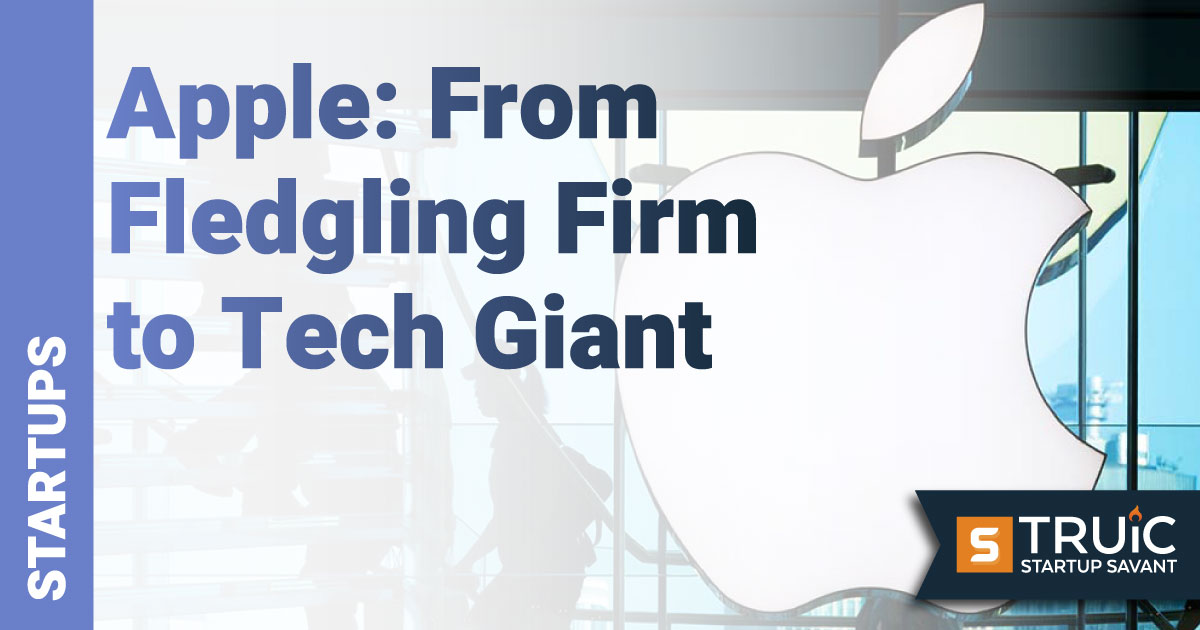Apple – From Fledgling Firm to Tech Giant
Apple’s Origin Story

Last Updated: By Madison Holt
Apple needs no introduction, but it wasn’t always a household name. In fact, the electronics giant that essentially invented the modern smartphone and today sells its products to eager customers all over the world has seen plenty of challenges, having to overcome everything from serious infighting to near bankruptcy. This is the story of how Apple started and grew and the strategies that have contributed to its success.
Apple Overview and History
Apple was founded in 1971 as Apple Computers, Inc., by Steve Jobs and Steve Wozniak. At that point, most computers were giant, complicated machines primarily intended for businesses. Jobs and Wozniak, both college dropouts, wanted to change that by creating a computer that was easy to use and that people could have in their homes.
The two men started building their first computer, the Apple I, in Jobs’ garage. The Apple 1 didn’t get a keyboard, monitor, or case until 1977. The next iteration, the Apple II, was the first computer to use color graphics. Sales took off, and Apple went public in 1980.
Wozniak left Apple in 1983 to pursue other interests. His replacement, John Sculley, became president. Jobs and Sculley didn’t get along, and eventually, Jobs was forced out of the company he co-founded. Undeterred, he founded another computer company called NeXT.
Apple continued to enjoy success throughout the 1980s, due primarily to decisions Jobs had made before he left. In particular, he had inked a deal with Adobe, the creator of the Adobe Portable Document Format (PDF). Together, the two companies invented the concept of desktop publishing.
On a more sour note, in 1985, Sculley rejected an offer from Microsoft to license Apple’s operating system. Microsoft’s operating system used a similar type of graphical interface, and apparently, Microsoft thought it would be a good idea to eliminate a competitor. But Sculley would have none of it. Microsoft became Apple’s biggest competitor, considerably surpassing its market share in terms of the number of machines with Microsoft’s operating system installed vs. Apple’s.
Due largely to Microsoft's competition, Apple’s fortunes fell dramatically between 1990 and 1996. It needed help staying afloat, so – in arguably one of the greatest ironies in US corporate history – it bought out NeXT, the company started by Jobs, who Apple had forced out years earlier. Jobs was brought on as Apple’s interim CEO. He immediately started making changes. One of the most consequential was to partner with Microsoft on a Mac version of the Microsoft Office software, which was rapidly gaining in popularity.
Jobs also pivoted Apple to making other products besides desktop computers, a move that did more than anything else to turn the company around. Apple introduced the iBook, a laptop computer, and the iPod, an mp3 player. Then, famously, in 2007, Apple introduced the iPhone, the first successful touch-screen cellular phone that changed how people interacted with these devices.
After Jobs’ death in 2011, Tim Cook became CEO. In the intervening years, Apple has not only launched many new versions of the iPhone, but has expanded into tablets (the iPad), smartwatches (the Apple Watch), streaming services (Apple TV+), Apple News (magazines and other publications), and credit cards (the Apple Card). In 2022, the company became the first US firm to reach a market value of $3 trillion.
Apple’s Business Model
Apple makes money primarily by selling products and subscriptions to various services. Most people are familiar with Apple’s products, including the iPhone, iPad, Apple Watch, MacBook laptops, and desktop computers. These represent the lion’s share of the company’s revenue, which comes to about $13 billion per quarter.
Apple also generates revenue through subscription services. For example, in addition to selling the Apple TV streaming device, it offers a streaming service called Apple TV+. Other subscription services include:
- Apple Fitness+: Offers thousands of video and audio workouts for all fitness levels through a mobile app, as well as personalized metrics from Apple Watch
- Apple Music: Competes with similar music streaming services like Spotify
- iCloud+: Expands the iCloud service with features like iCloud Private Relay, Hide My Email, HomeKit Secure Video support, and data storage
- Apple Arcade: Offers access to more than 180 games on a subscription basis
A large majority of Apple’s revenue comes from iPhone sales. According to Business Model Analyst, the company’s revenue streams break down as follows:
- iPhone: 62.3%
- Services: 14%
- Mac: 9.6%
- iPad: 7.1%
- Other Products: 6.7%
In addition, Bloomberg reports that Apple is developing a hardware subscription service for iPhones. This would entail paying a subscription fee for a phone instead of owning it outright.
The company makes money in other ways as well. For example, like many electronics companies, Apple offers extended warranties for an extra fee. It also takes 30% from every transaction conducted through in-app purchases on iPhones and iPads.
Through these various channels, Apple became the first company to achieve a market cap of more than $1 trillion. Its market cap was about $2.61 trillion in January 2022.
A large part of Apple’s success stems from the fact that it designs its own hardware, operating systems, software, and services. This allows the company to maintain strict control over how all of these elements function individually and work together. In turn, customers get a more cohesive experience with products that are easy to use and automatically compatible.
The result is that customers often find themselves “locked in” to Apple’s ecosystem. In other words, the more Apple products and services someone owns or subscribes to, the harder it can be to switch to another company.
By contrast, Windows computers are built by many manufacturers and run software produced by a large number of companies in addition to Microsoft. While this provides considerable flexibility for consumers, it also virtually guarantees that they will experience compatibility issues between hardware and software from time to time.
If there’s a weakness in Apple’s business model, it’s that the company relies so heavily on iPhone sales. Many of its other products aren’t as dominant, although it did rank third among vendors for US personal computer shipments in the second quarter of 2022. As for Apple’s services, it has plenty of well-established competition in areas like video streaming, music streaming, and cloud storage.
Apple’s Marketing Strategies
Apple takes a different approach to marketing than many other companies. While most of its competitors conduct extensive market research into what customers want, Apple has historically preferred to design unique and minimalist yet innovative products that people end up wanting after seeing them.
In general, its marketing efforts are relatively cost-effective because it designs and produces its own software and hardware, which makes it easier to communicate its value proposition to customers.
According to Business Research Methodology, Apple’s marketing strategy involves:
Emphasizing Value Rather Than Cost
Although Apple’s products are relatively expensive, it tries to persuade buyers that the extra cost is justified through unique, aesthetically pleasing designs; intuitive operation; products that “just work” without much, if any, effort on the consumer’s part; and innovative features.
Using Product Placement Effectively
Unlike most companies, Apple doesn’t rely on Pay-Per-Click (PPC) online ads. Instead, it focuses on product placement and generating hype around those products. Apple does this through celebrity endorsements, TV shows and movies, and well-advertised “launch events” where its latest gadgets are introduced with much fanfare.
Generating Glowing Media Reviews
By producing high-quality products and generating buzz around them, Apple generates reviews in both traditional and social media. The company also makes a point of sending products to reviewers, often before they go on sale.
The result is that consumers can easily find reviewers who heap praise on Apple’s phones, tablets, and other gadgets. For example, the latest iPhone is on virtually every publisher’s list of best cell phones every year.
Effectively Using Video Viral Marketing
Apple has mastered the art of using video and viral marketing to tell inspiring stories about its products. These ads resonate with viewers, particularly younger ones, who remember them the next time they’re looking to buy a phone, tablet, or computer.
There are other reasons for Apple’s marketing success as well. According to Startup Talky, these include:
- Simple design aesthetics
- Clear ad copy that’s easy to read
- Short product names that are easy to remember
- Products that don’t overwhelm consumers with too many choices
- Deep knowledge of their target audience’s likes, dislikes, and habits
- Deemphasizing technical specifications while still mentioning them for those who are interested
- Beautiful, easy-to-navigate websites
- Ads that show people enjoying Apple products rather than focusing on specific features (e.g., storage or battery life)
- Ensuring that the customer experience in both purchasing and using products is pleasant and seamless
- Building a community of loyal users who want to be part of the “club.”
What’s Next for Apple
At its annual developers' conference in June 2022, Apple made several announcements about upcoming products and services. According to CNET, these include:
iOS 16 Updates
With the recently released iOS 16, users can customize their experience on their iPhones and iPads more than ever. For example, they will be able to choose fonts and colors on the lock screen, rotate photos, and use widgets.
Some of the other announced features include text messages that can be edited, recalled, and marked unread; better integration of SharePlay with FaceTime and Messages; the ability to use dictation for input at any time; tap-to-pay capability on iPhones; and expanded sports coverage for Apple News.
iPads will also get a virtual shared whiteboard app called Freeform, as well as better multitasking and other enhancements to make interacting with an iPad more like interacting with a computer.
Upgrades to MacBook Air
The Apple Air laptop will get the company’s latest M2 chip, new colors, MagSafe fast charging, a brighter screen, a high-definition (1080p) webcam, and four-speaker audio with three microphones.
A New Version of MacOS and WatchOS
The latest version of MacOS, Ventura, will provide many improvements and tweaks, including:
- Improved management of windows in Stage Manager
- Better search functionality in Spotlight, including web images and sports, as well as full-window search results
- Upgrades to Safari, including Touch ID, Face ID, and the ability to share tab groups
- Handoff for FaceTime so you can start a conversation on one device and finish it on another.
WatchOS version 9 will include new watch faces, allow users to pin apps at the top of the dock, provide new banner notifications and parental controls for podcasts, and offer more workout and health metrics.
Tell Us Your Startup Story
Are you a startup founder and want to share your entrepreneurial journey with our readers? Click below to contact us today!


